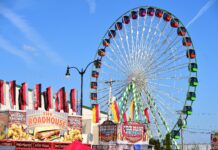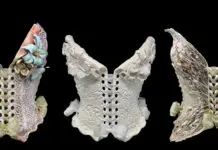Secret underground passageways, kidnappers and oil-tycoon millionaires. It’s got all the makings of a Gothic thriller movie. But, instead, it’s right in our backyard.
Buried beneath downtown Tulsa, a system of underground tunnels was built to connect Tulsa’s early skyscrapers. According to history, the tunnel system was first designed for freight, but soon became a millionaire’s highway, keeping Tulsa’s wealthy and prominent citizens safe from harm.
Construction began on the Tulsa tunnels in 1929. The first was an 80-foot-long tunnel that connected the Philtower with the Philcade building. The tunnel was originally designed as a way to transport materials between the two buildings. However, due to a rash of kidnappings of wealthy businessmen in Chicago, oil tycoon and millionaire Waite Phillips used it as a way to move safely between the two buildings. This tunnel is no longer open to the public.
The rest of the tunnels were built later in Tulsa history. All in all, the tunnels connect eight buildings, three parking garages, a hotel and numerous restaurants and small businesses. There are other special finds in the tunnels, too. The office for the Tulsa Foundation for Architecture is located at the bottom of the Kennedy Building. They have several historic artifacts and displays in their window for the public to view. Some of the tunnels include historic photos of downtown Tulsa as well.
Today, the tunnels are used by the downtown crowd to get to and from buildings during inclement weather or just for a fun change of pace. It is possible through a combination of tunnels, sky bridges and building corridors to go from 5th and Boston to 1st and Main Street without ever venturing outside.
The tunnels that are still open to the public are well lit and easily accessible, but they can be confusing for first timers.
Andrea Myers, a public relations professional for the Bank of Oklahoma, is a huge fan of the tunnels.
“To me, it is a magical place in Tulsa history,” Myers says. “I use the tunnels regularly to take me from my office at BOK to other areas in the central business district.”
Myers loves to take people on informal tours of the Tulsa tunnels. However, Bandana Tours offers official tours of the subterranean passageways that take one to three hours with lunch included. In addition to seeing the tunnels and the beautifully ornate Art Deco buildings, tour guides offer glimpses into the lives of the Native Americans, cowboys and oil barons that shaped early Tulsa.
Allison Froeschle, owner of Bandana Tours says out-of-town people are surprised to see how many beautiful buildings there are in downtown Tulsa.
“Even locals, some whom worked downtown in the ‘40s, ‘50s and ‘60s, are surprised to take a look around again and see things they didn’t see when they were young,” Froeschle says.
“My favorite part of the tunnels are the large photographs dated from 1897 to 1937,” Froeschle says. “They help to tell the story of Tulsa in such a visual way.
“I especially love taking children into the buildings and having them express such joy at seeing the beauty there – the ‘ooohs’ and ‘aaahs’ make me smile.”
Underground OKC
Tulsa’s isn’t the only historic underground in the state. The Underground in Oklahoma City is also strongly rooted in local history and helps savvy residents move around the downtown area.
The Underground in downtown Oklahoma City is a three-quarter-mile tunnel system that connects 16 city blocks and more than 30 buildings. Construction of the first tunnel took place in the early 1930s, with mostly wild rumors and urban legends fillings its history until expansion of the underground in the 1970s. Those colorful local myths include everything from rumors of opium dens housed within to inebriated bar patrons finding themselves locked below ground. The reality was far less adventuresome, and tunnel speculation grew quiet for decades after initial construction.
However, in the 1970s and 1980s, banker Jack Conn led the charge to further develop the tunnels, which became known as The Conncourse in his honor. The Conncourse became a bustling place, complete with services, shops, restaurants and other convenient amenities to meet the needs of local bankers, lawyers and oil industry execs.
Following the collapse of the last oil boom, Oklahoma City’s underground fell into disrepair and out of fashion, being closed to the public at times.
However, in 2006 architect Rand Elliott led a $2 million renovation effort that transformed “The Conncourse” into the “Underground,” complete with an exciting lighting plan, new wall colors, a graphics/signage system and a gallery-style display of historic downtown photographs. The Invited Artists Gallery in the Underground is now open and features the shows created by Oklahoma artists. The Invited Artists Gallery sits underneath the intersection of Robinson and Robert S. Kerr with entrances from all adjacent buildings.
Today, once again an important part of downtown Oklahoma City, the Underground demonstrates that vibrant city life in Oklahoma extends beneath the surface.


























